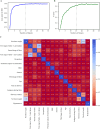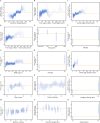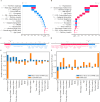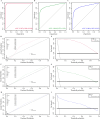Integrating SHAP analysis with machine learning to predict postpartum hemorrhage in vaginal births
- PMID: 40319253
- PMCID: PMC12048952
- DOI: 10.1186/s12884-025-07633-w
Integrating SHAP analysis with machine learning to predict postpartum hemorrhage in vaginal births
Abstract
Objective: This study aimed to develop a machine learning (ML) model integrated with SHapley Additive exPlanations (SHAP) analysis to predict postpartum hemorrhage (PPH) following vaginal deliveries, offering a potential tool for personalized risk assessment and prevention in clinical settings.
Methods: We conducted a retrospective multicenter cohort study in Northeast China, including women who had vaginal deliveries at three tertiary hospitals from September 2018 to December 2023. Data were extracted from electronic medical records. The dataset was split into a training set (70%) and an internal validation set (30%) to prevent overfitting. External validation was performed on a separate dataset. Several evaluation metrics, including the area under the receiver operating characteristic curve (AUC), were used to compare prediction performance. Features were ranked using SHAP, and the final model was explained.
Results: The XGBoost model demonstrated superior predictive accuracy for PPH, with an AUC of 0.997 in the training set. SHAP value-based feature selection identified 15 key features contributing to the model's predictive power. SHAP dependence and summary plots provided intuitive insights into each feature's contribution, enabling the identification of anomalies. The final model maintained high predictive power, with an AUC of 0.894 in internal validation and 0.880 in external validation.
Conclusion: This study successfully developed an interpretable ML model that predicts PPH with high accuracy. Future studies with larger and more diverse datasets are necessary to further validate and refine the model, particularly to assess its generalizability across different populations and healthcare settings.
Keywords: Interpretable model; Postpartum hemorrhage; SHAP; Vaginal births; XGBoost.
© 2025. The Author(s).
Conflict of interest statement
Declarations. Ethics approval and consent to participate: Ethics approval and consent to participate: The study was approved by the Ethics Committee of Shengjing Hospital of China Medical University (No. 2016PS344K, Date.17/12/2016). All participants provided informed consent. Consent for publication: Not Applicable. Competing interests: The authors declare no competing interests.
Figures








Similar articles
-
Interpretable machine learning predicts postpartum hemorrhage with severe maternal morbidity in a lower-risk laboring obstetric population.Am J Obstet Gynecol MFM. 2024 Aug;6(8):101391. doi: 10.1016/j.ajogmf.2024.101391. Epub 2024 Jun 6. Am J Obstet Gynecol MFM. 2024. PMID: 38851393
-
Machine learning-based prediction of postpartum hemorrhage after vaginal delivery: combining bleeding high risk factors and uterine contraction curve.Arch Gynecol Obstet. 2022 Oct;306(4):1015-1025. doi: 10.1007/s00404-021-06377-0. Epub 2022 Feb 16. Arch Gynecol Obstet. 2022. PMID: 35171347
-
Explainable Machine Learning Model for Predicting Persistent Sepsis-Associated Acute Kidney Injury: Development and Validation Study.J Med Internet Res. 2025 Apr 28;27:e62932. doi: 10.2196/62932. J Med Internet Res. 2025. PMID: 40200699 Free PMC article.
-
Non-invasive Prediction of Lymph Node Metastasis in NSCLC Using Clinical, Radiomics, and Deep Learning Features From 18F-FDG PET/CT Based on Interpretable Machine Learning.Acad Radiol. 2025 Mar;32(3):1645-1655. doi: 10.1016/j.acra.2024.11.037. Epub 2024 Dec 10. Acad Radiol. 2025. PMID: 39665892
-
Development and internal validation of an interpretable risk prediction model for diabetic peripheral neuropathy in type 2 diabetes: a single-centre retrospective cohort study in China.BMJ Open. 2025 Apr 3;15(4):e092463. doi: 10.1136/bmjopen-2024-092463. BMJ Open. 2025. PMID: 40180384 Free PMC article.
References
-
- Patek K, Friedman P. Postpartum Hemorrhage-Epidemiology, risk factors, and causes. Clin Obstet Gynecol. 2023;66(2):344–56. - PubMed
-
- Faysal H, Araji T, Ahmadzia HK. Recognizing who is at risk for postpartum hemorrhage: targeting anemic women and scoring systems for clinical use. Am J Obstet Gynecol MFM. 2023;5(2s):100745. - PubMed
-
- Gonzalez-Brown V, Schneider P. Prevention of postpartum hemorrhage. Semin Fetal Neonatal Med. 2020;25(5):101129. - PubMed
Publication types
MeSH terms
Grants and funding
LinkOut - more resources
Full Text Sources
Medical

